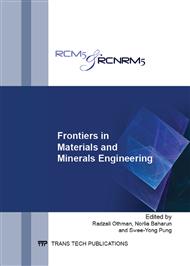p.184
p.190
p.199
p.205
p.212
p.221
p.228
p.236
p.243
Viscosity Effect on the Reinforcement Properties of Silica Filled ENR Rubber Compound
Abstract:
Since the introduction of the so-called Green Tyre concept, in the early 90ies, the use of silica as reinforcing fillers has spread and grown worldwide. The general advantages of silica as reinforcing filler over carbon black filler are better rolling resistance by achieving at least equal wet traction while tread wear should not be adversely affected.In general, high filler loading attributes poor dispersion and lack of adhesion to the rubber matrix which in turn affect the processability and physical properties of the rubber compounds. In this work, the objective of the study was to investigate the influence of viscosity on silica dispersion and in relation to mechanical and performance properties of Epoxidised Natural Rubber (ENR) compound. The viscosity of the compound was measured via viscometer. The filler flocculation and dispersion was monitored by following the changes in torque and storage modulus at low strain using rheometer MDR 2000 and DisperGrader. The filler network on the other hand was characterised by Rubber Processing Analyzer (RPA) and bound rubber measurements. The physical tests were also done according to the ASTM methods such as tensile strength and abrasion. Results showed that low viscosity of rubber will facilitate further the dispersion of the filler in the system although other physical properties will be affected.
Info:
Periodical:
Pages:
212-217
Citation:
Online since:
November 2013
Keywords:
Price:
Сopyright:
© 2014 Trans Tech Publications Ltd. All Rights Reserved
Share:
Citation:


